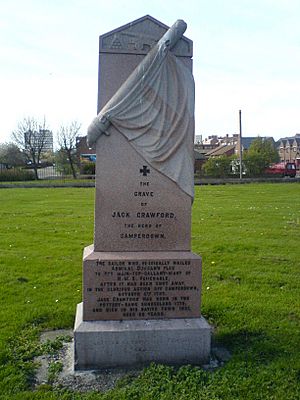Jack Crawford (sailor) facts for kids

Jack Crawford (born March 22, 1775 – died November 10, 1831) was a brave sailor in the Royal Navy. He became very famous for his actions during the Battle of Camperdown in 1797. Because of this, he is known as the "Hero of Camperdown."
Contents
Jack Crawford was born in the east end of Sunderland. When he was young, he trained as a keelman, which was someone who worked on boats called keels, transporting coal. In 1786, when he was only 11 or 12 years old, he joined the crew of a ship called the Peggy in South Shields as an apprentice.
Later, in 1796, Jack was forced to join the Royal Navy. This was a common practice at the time called impressment, where men were made to serve in the navy. He served on a ship called HMS Venerable. His commander was Admiral Duncan, who was in charge of the Royal Navy in the North Seas.
The Hero of Camperdown
The Battle of Camperdown happened on October 11, 1797. HMS Venerable was Admiral Duncan's main ship during this important battle. At one point, part of the ship's mast was knocked down. This included the admiral's flag, which was a very important symbol. If the admiral's flag was lowered, it could look like the ship was giving up.
Seeing this, Jack Crawford bravely climbed the damaged mast. He then nailed the admiral's flag back to the very top of the mast. This showed everyone that the ship was still fighting and would not surrender!
Life After the Battle
After the Royal Navy won the battle, there was a big celebration in London. Jack Crawford was officially introduced to King George III. The King gave him a special payment of £30 every year for the rest of his life. The people of Sunderland also gave him a silver medal to honor his bravery.
However, Jack Crawford later faced difficult times and had to sell his medal. In 1831, he became one of the first people in Sunderland to die from a serious illness called the cholera epidemic. He was buried in a simple grave without a headstone because he was very poor.
Remembering Jack Crawford
Many years later, people became interested in the "Hero of Camperdown" again. In 1888, a headstone was placed in the churchyard of Holy Trinity, Sunderland to mark his grave. Two years after that, in 1890, a large monument was built in Mowbray Park to remember him.
There was even a pub in Monkwearmouth named "The Jack Crawford." It had a carved figure of him on the side. The pub was destroyed during World War II, but the figure was saved. For a while, it was shown at the Sunderland Museum.
The Sunderland Museum still thinks highly of Jack Crawford. They had an exhibition about him for the 200th anniversary of the Battle of Camperdown. One of their learning rooms is named after him. You can also see special pottery from the 1800s that celebrates Jack Crawford. The original silver medal given to him by the town is also proudly displayed in the Sunderland Heroes section of the museum.

